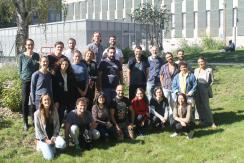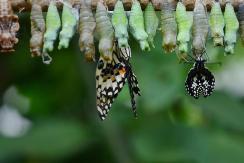COEVOL Multi-Scale Coevolution
Living systems are highly integrated, with a multitude of levels of organization, from molecular and intra-cellular scales to ecosystems. Complex organisms are themselves consortia of macro- and micro-organisms, which work together with their host to build the individual. Yet, each of these organisms can function and evolve in the short term according to its own logic, possibly in conflict with other higher or lower levels, or with other time scales. The once common idea among evolutionists that natural selection results in organisms perfectly adapted to their environment is now severely undermined. Not only because, as the Red Queen explains to Alice, one has to run relentlessly to keep its place in a changing environment, or because past evolutionary history and chance constrain the possibilities of present adaptation, but also because different levels of selection have interests that are generally difficult to reconcile.
Multi-scale coevolution resets classical questions in evolutionary biology
One example, of particular interest is the question of the source of heritable variations. The phenotype of organisms in a population is influenced not only by variations in their nuclear and mitochondrial genomes, the dynamics of which is the object of population genetics, but also more and more patently by the consortium of microbes and genetic elements that constitute its microbiome and virome. The hologenome designates this complex assembly of genetic materials, which obey different rules of transmission and different evolutionary strategies. The ability of symbionts to manipulate host phenotypes or to interfere with each other influences the evolutionary dynamics of all players in ways that are yet poorly understood. In addition, new questions arise, such as the importance of co-adaptation in these systems and their consequences in maintaining cohesive biological systems.
- Symbiosis: a response to and a source of divergent selection
Using a variety of approaches combining experimental evolution, genomic, functional, phenotypic and behavioral data, we aim to test whether symbiosis facilitates diversification and to characterize the underlying microevolutionary processes.
- Ecological networks of horizontal gene transfer
We develop original methods to detect gene transfer and we investigate the factors that influence the routes of gene transfers among microbes but also among insects.
- The interplay between symbiosis, infection and immunity and its evolutionary consequences
We try to understand the intimate interaction of hosts with pathogens, symbionts and transposable elements and how it affects the extended phenotype of the host.
- Transgenerational inheritance and environment changes
We try to decipher the molecular mechanisms that underlie rapid adaptation to environment and to test for transgenerational inheritance of fitness traits.
- Intragenomic conflicts and demography
We are developing models to test whether changes in the demography of the host affect the dynamics of transposable elements.
- The determinism of phenotypic convergence
We study the genomic basis of convergent phenotypic evolution in particular in the case of animals and plants adaptation to increasing temperature and decreasing water.
- Reconciling the tree of life
We develop phylogenetic methods for “reconciling” gene/species or host/symbiont histories and use these methods to explore the bulk of extinct or undescribed species and the history of association of symbiotic microbes with their hosts.
Integrating methods
The methods we use to tackle the questions raised by multi-scale co-evolution extend from theory, modelling and simulation to big data analysis, lab (notably on insects), and to a lesser extent, field activities.
Implication of research, responsibility of researchers and citizen sciences
From our research (some of which have immediate consequences in health, agriculture and ecology) and our concerns about the responsibility of scientists in society, we are committed to promote an “implicative” research. The implicative position means that we try to work on the link between science and society, not only through a one-way communication, applying or explaining our science, but also favoring early discussions on research projects, that may influence our research directions.
Publications
Display of 451 to 480 publications on 710 in total
Multiple Nuclear Gene Phylogenetic Analysis of the Evolution of Dioecy and Sex Chromosomes in the Genus Silene
PLoS ONE . 6 : e21915
Journal article
see the publicationHDR - Evolution combinatoire Algorithmique des chromosomes
incollection . -- : 54-56
Journal article
see the publicationVertical and horizontal transmission drive bacterial invasion
Molecular Ecology . 20 ( 17 ) : 3496 - 3498
Journal article
see the publicationMeiotic recombination favors the spreading of deleterious mutations in human populations
Human Mutation . 32 ( 2 ) : 198-206
DOI: 10.1002/humu.21407
Journal article
see the publicationEuclidean nature of phylogenetic distance matrices
Systematic Biology . 60 ( 6 ) : 826--832
Journal article
see the publicationBacterial symbionts in insects or the story of communities affecting communities.
Philosophical Transactions of the Royal Society B: Biological Sciences . 366 ( 1569 ) : 1389-400
Journal article
see the publicationIntraspecific specialization of the generalist parasitoid Cotesia sesamiae revealed by polyDNAvirus polymorphism and associated with different Wolbachia infection.
Molecular Ecology . 20 ( 5 ) : 959-71
Journal article
see the publicationEndosymbionts of arthropods and nematodes: allies to fight infectious diseases?
Médecine/Sciences . 27 ( 11 ) : 953-958
Journal article
see the publicationSurvey of Wolbachia and Its Phage WO in the Uzifly texitExorista sorbillans (Diptera: Tachinidae)
Current Microbiology . 63 : 267-272
Journal article
see the publicationIsolation and gene flow: inferring the speciation history of European house mice
Molecular Ecology . 20 : 5248-5264
Journal article
see the publicationTpms: a Tree Pattern-matching Utility for Querying Gene Trees Collections
Journées Ouvertes Biologie Informatique Mathématiques (JOBIM) . : 111-112
Conference paper
see the publicationMapping ancestral genomes with massive gene loss: a matrix sandwich problem.
Bioinformatics . 27 ( 13 ) : i257-65
Journal article
see the publicationL'époque romantique contre la peine de mort
incollection . -- : 54-56
Journal article
see the publicationReconstructing the architecture of the ancestral amniote genome.
Bioinformatics . 27 ( 19 ) : 2664-2671
Journal article
see the publicationPreface : Satellite Workshop on Comparative Genomics Research in Computational Molecular Biology (RECOMB-CG 2010)
Journal of Computational Biology . 18(9) : 1-3
Journal article
see the publicationVertical inheritance and bursts of transposition have shaped the evolution of the BS non-LTR retrotransposon in Drosophila.
Molecular Genetics and Genomics . 286 ( 1 ) : 57-66
Journal article
see the publicationComparative analysis of transposable elements in the melanogaster subgroup sequenced genomes.
Gene . 473 ( 2 ) : 100-9
Journal article
see the publicationLes Ressources
Actes du Colloque de l'Institut Universitaire de France . : 356 p.
Conference paper
see the publicationMedicago truncatula contains a second gene encoding a plastid located glutamine synthetase exclusively expressed in developing seeds
BMC Plant Biology . 10 ( 183 ) : 16 p.
Journal article
see the publicationInduction by Chlorpyrifos of the Confusion of Males in Discriminating Female Sexual Pheromones Used for Mate Finding by Two Sympatric Trichogramma Species (Hymenoptera: Trichogrammatidae)
Environmental Entomology . 39 ( 2 ) : 535-544
Journal article
see the publicationDecrease in Fecundity Induced by Interspecific Mating Between Two Trichogramma Parasitoid Species
Journal of Economic Entomology . 103 ( 2 ) : 308-313
Journal article
see the publicationLa notion d'espèce en écologie microbienne
1er Colloque National d'Ecologie Scientifique .
Conference paper
see the publicationToward an ecological concept for bacterial species in Agrobacterium
12th International Conference on Plant Pathogenic Bacteria .
Conference paper
see the publicationIdentification de fonctions « spécifiques d'espèce » impliquées dans l'individualisation en écovar de l’espèce G8 du complexe Agrobacterium tumefaciens
Journées des Microbiologistes de l'INRA .
Conference paper
see the publicationEvolution Moléculaire
Biologie évolutive . 978-2-8041-0161-9 : 114-173
Book chapter
see the publicationDetecting lateral gene transfers by statistical reconciliation of phylogenetic forests
BMC Bioinformatics . 11 ( 324 ) : 13
Journal article
see the publicationBayesian sampling of genomic rearrangement scenarios via double cut and join.
Bioinformatics . 26 ( 24 ) : 3012-9
Journal article
see the publicationAncestral grass karyotype reconstruction unravels new mechanisms of genome shuffling as a source of plant evolution.
Genome Research . 20 ( 11 ) : 1545-57
Journal article
see the publication

